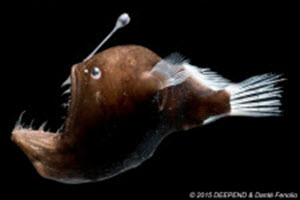
One of many fascinating creatures in the deep Gulf of Mexico is the Melanocetus johnsoni. This anglerfish has a fleshy growth from its head (the esca or illicium) that acts as a lure. (Photo by Dante Fenolio)
The Deep-Pelagic Nekton Dynamics (DEEPEND) consortium expands knowledge as a restoration tool for the Gulf’s largest ecosystem
Much uncertainty remains about impacts on the deep-sea environment from the 2010 oil spill that erupted more than 5,000 feet below the sea surface. However, knowing what was affected or what may change in the future is particularly difficult with little to no pre-existing knowledge about this obscure ecosystem. Environmental impact assessments of an area require some baseline of what lives and happens there.Scientists with the consortium Deep-Pelagic Nekton Dynamics of the Gulf of Mexico, or DEEPEND, are working to improve our understanding of the deep Gulf’s life and processes since the Deepwater Horizon oil spill. DEEPEND recently completed the first year of a multi-year Gulf of Mexico Research Initiative grant. Consortium director Tracey Sutton, Associate Professor and biological oceanographer at Nova Southeastern University, shared some thoughts about their project, goals, and accomplishments so far:
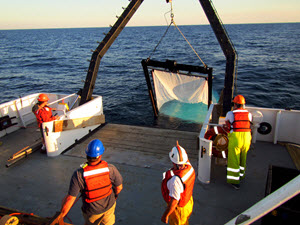
DEEPEND scientists conduct midwater trawling from the R/V Point Sur using an opening-closing MOCNESS trawl with a 10 m² mouth area. (Photo provided by DEEPEND)
The energy industry is working in deep realms that haven’t been censused properly. Our research will help us know more about the deep Gulf than we know about any deep-pelagic ecosystem on Earth. We can’t see it, we don’t fish much of it directly, but it really matters.
Learning About the Deep Gulf
Understanding why the deep Gulf matters is one of the main goals for the DEEPEND research team. Prior to this project, some members of the DEEPEND team were studying the world’s oceans and learned things that changed their understanding of deep-ocean life, as Sutton described:
The scientific community has likely underestimated the amount of deep-pelagic fish biomass in the world’s oceans by an order of magnitude. These deep fish mediate a lot of carbon transfer through their grazing and consumption of plankton. The number of species in the Gulf of Mexico is high, and we are finding new things all the time – it’s one of the most species-rich deep-pelagic ecosystems in the world.

To collect samples at deep depths, researchers use long lengths (2.5 miles!) of conducting cable on the R/V Point Sur. (Photo provided by DEEPEND)
The DEEPEND teams seeks to expand knowledge about the deep Gulf as a restoration tool for this immense and poorly understood system and, thereby, improve our ability to gauge its health. Being able to gauge the health of the Gulf is tied to understanding its deep-water biomass, which Sutton referred to as their “unit of currency” for ecological studies:
To track an ecosystem’s health, you have to track living carbon or biomass, from microscopic plant life and zooplankton to larvae and animals. We need to understand how much biomass is out there, where it is distributed, and how often it replaces itself.
The DEEPEND research project continues the work that NOAA contracted Sutton and colleagues to conduct as part of the 2010 Natural Resource Damage Assessment. Their team led an exploratory survey that included 230 sea days, collecting data from three Gulf domains: the bathypelagic, or “midnight zone” waters (>1000 m depth), the middle “twilight zone” waters (200-1000 m depth), and the epipelagic “surface zone” waters. They realized there was an enormous amount of basic science that had yet to be conducted.
The DEEPEND project expands their past work to determine the deep Gulf’s natural variability on an annual basis, a critical component needed to understand effects of a specific event like an oil spill. Sutton said that building upon that initial ten-month continuous data set from 2010 provides an unprecedented opportunity to understand a deep-ocean system in a larger context.
Deep Sea Explorations
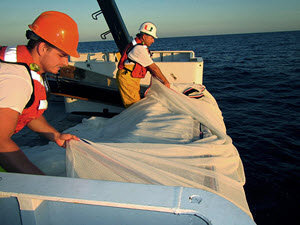
DEEPEND researchers pull in the nets of the MOCNESS to see what they have collected. (Photo provided by DEEPEND)
The DEEPEND team completed four expeditions in 2015 and plan to do the same in 2016 and 2017 to assess the deep-pelagic community through sampling, acoustical sensing, modeling, and laboratory analyses. They sort, count, and weigh the majority of samples collected while onboard, prepping them for more detailed analyses later. So far, they have collected 2,275 fish samples and identified 375 taxonomic groups and 72 species. They expect to discover new species like they did last year with a new anglerfish Lasiognathus dinema and a new dragonfish.
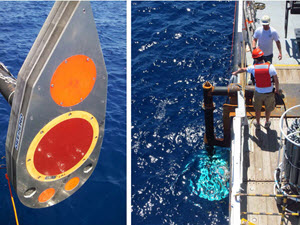
Hydroacoustics transducer (left) and transducer in sensing mode (boom lowered) on R/V Point Sur during DEEPEND cruise. (Photo provided by DEEPEND)
Researchers will use acoustic sensing data to identify layers of fish and their horizontal and vertical distribution at specific depths, which will help them see large scale patterns of biomass. They want to make their data available as soon as possible, especially for their biophysical modelers who will help them identify drivers of variability and investigate possible effects from the spill on ecosystem attributes.
Knowing where to collect samples in the deep ocean is challenging. Sutton described the surface as looking like one big mass of blue water, but underneath there is a lot of physical movement and structure. That is where the DEEPEND partners at the Naval Research Laboratory with their advanced computational models come into play. They tell the researchers what the sea conditions will be so they can collect samples across large physical features such as eddies and Mississippi River flows.
Data to Assess Change
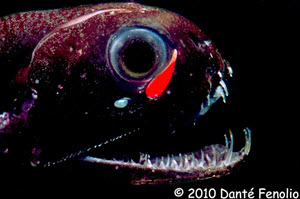
Pachystomias microdon, the smalltooth dragonfish, is one of the few creatures on Earth who can produce red light. (Photo by Dante´ Fenolio)
The team will use data obtained during the 2010-2011 and 2015-2017 periods to establish time-series data for detecting ecosystem shifts or responses. According to Sutton, the DEEPEND project should produce enough data to model variability, which is rare for a deep system:
We hope to establish a kind of bellwether for the Gulf’s overall health and inspire long-term monitoring efforts. These datasets will help us detect change. Our best shot for understanding the impact of an event is to understand what drives natural variability, the backdrop for detecting specific change.
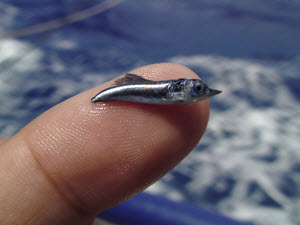
A juvenile blue marlin. Shelf and slope waters in the Deepwater Horizon spill area serve as critical spawning, nursery, and foraging habitat of several important oceanic species (billfishes, tunas, swordfish, dolphinfishes). Ichthyoplankton surveys will help DEEPEND investigate potential ecological effects of the spill on early-life stages of pelagic fishes. (Photo provided by Jay Rooker)
The DEEPEND team is also seeking to understand the connectivity of the Gulf with the Atlantic Ocean basin. Sutton explained how this ties to assessment:
When looking at the impact of a specific event like an oil spill, you need to know if the things that live in the Gulf are residents or if they are part of a larger continuum of life that flux into and out of the Gulf. These are two very different things for assessment. If something is a resident, an event such as an oil spill could denude a whole population, and it would take time for it to replace itself.
Following the Gene Flow
The DEEPEND genetic studies are an important component to understanding life in the deep Gulf. Researchers will assign most samples a genetic barcode or fingerprint and then run a full genome sequence on selected model species. The team will look at the basic connectivity of individuals within a larger population, and genetically match an early life stage of one thing to an older life stage of something that might look quite different. This research will help improve understanding about the genetic diversity in deep sea populations, and Sutton explained how this improves impact assessment:
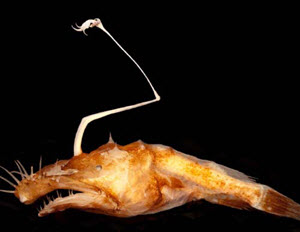
DEEPEND researchers found a new species of deep-sea anglerfish, Lasiognathus dinema, between 1,000-1,500 meters depth in the northern Gulf of Mexico (Pietsch and Sutton, 2015). Newsweek chose this species as one of the top 20 new species discovered in 2015. (Photo by Theodore Pietsch)
Assessing genetic diversity plays a key role in evaluating the status of populations and in conservation and management efforts. We can determine genetically if a population has undergone a recent drastic reduction of numbers. We will examine if the oil spill impacted population sizes of fishes and invertebrate species enough to cause a reduction in their genetic diversity.
Sharing Science Discoveries
The DEEPEND team will share their research with several audiences: the scientific community, the formal education community, and the broader public through private sector groups such as the San Antonio Zoo and the Oregon Coast Aquarium. The team is creating an image and genetic atlas of Gulf of Mexico fish, larvae, and microbes with over 7,000 samples photographed. Sutton explained why their group is particularly excited about outreach:
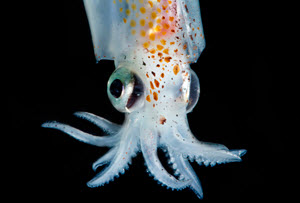
Squid Abralia redfieldi. (Photo by Dante´ Fenolio)
Deep-water environments have this “Jacques Cousteau” appeal. Apart from space, it’s one of the few places where we have a real shot at seeing something brand new, something that likely has huge teeth and light organs. We want to share our discoveries so people will know that the ocean is full of an amazing variety of life.
They already have experienced great success at reaching large student groups through the help of their partners at Whale Times, who developed an experiential online classroom event “Creep into the DEEPEND.” Last year 7,000+ students enrolled, and they and their teachers became Virtual Science Team Members. The outreach team plans to build on this success, as Sutton described:
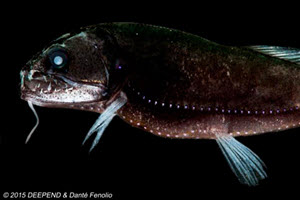
Astronesthes macropogon have a bioluminescent whisker-like sensory organ that attracts small prey into striking distance. (Photo by Dante´ Fenolio)
There’s no better way to get the word out than to show people what’s down there. Creep into the DEEPEND used our activities, photos, videos, Skype interviews, and SeaMail to help students and teachers discover Gulf animals, research, and scientists. This year, we will offer 20+ Creep into the DEEPEND Summer Camp classes to 12 museums/science centers. There is plenty of fascination with science, and I think there is a little scientist in everybody.
Scientist Danté Fenolio, the DEEPEND photographer, has a new book that will be released soon that credits the consortium’s work: Life in the Dark: Illuminating Biodiversity in the Shadowy Haunts of Planet Earth.
Team DEEPEND
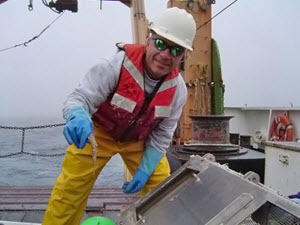
Dr. Tracey Sutton, director of the DEEPEND consortium. (Photo provided by DEEPEND)
Sutton considers one of the most valuable aspects of the DEEPEND consortium to be the many scientists who work together on different components towards a common goal. This diverse research group can ask better questions – and find better answers – than if they worked separately.
The DEEPEND project’s member institutions include Nova Southeastern University, Florida International University, the Naval Research Laboratory, Texas A&M University Galveston, the University of South Florida, the University of South Florida St. Petersburg, Florida Atlantic University, NOAA, Stony Brook University, the University of Illinois at Urbana-Champaign, the San Antonio Zoo, Durango Multimedia, Resphera Biosciences, and Whale Times . Click here for a list of individual participants and roles.
For more information about the DEEPEND program, click here or visit the DEEPEND website.
************
The Gulf of Mexico Research Initiative (GoMRI) is a 10-year independent research program established to study the effect, and the potential associated impact, of hydrocarbon releases on the environment and public health, as well as to develop improved spill mitigation, oil detection, characterization and remediation technologies. An independent and academic 20-member Research Board makes the funding and research direction decisions to ensure the intellectual quality, effectiveness and academic independence of the GoMRI research. All research data, findings and publications will be made publicly available. The program was established through a $500 million financial commitment from BP. For more information, visit http://gulfresearchinitiative.org/.
